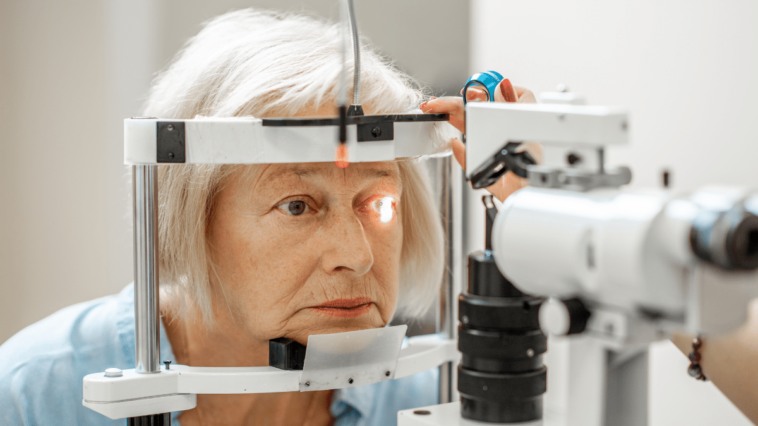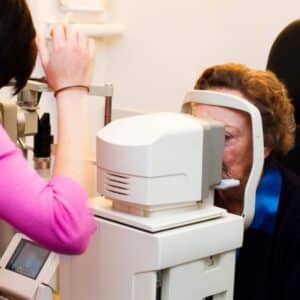What is Open-Angle Glaucoma?
Open-angle glaucoma is an eye disease characterized by damage to the optic nerve, which can lead to permanent vision loss. It occurs when the fluid in the eye does not drain properly, causing pressure to build up in the eye. This pressure, known as intraocular pressure (IOP), damages the optic nerve over time.
The term “open angle” refers to the angle between the iris and cornea appearing normal and open on examination, but the fluid inside the eye cannot flow through the drainage channels.
Open-angle glaucoma typically develops slowly and without noticeable symptoms until significant vision loss occurs. Risk factors for developing the disease include age, family history of glaucoma, and certain medical conditions, such as high blood pressure and diabetes. Early detection and treatment are crucial to preventing permanent vision loss from open-angle glaucoma.
What is the Difference Between Open and Closed-Angle Glaucoma?
Open-angle and closed-angle glaucoma are two different types that affect the eye in different ways.
Open-angle glaucoma is an ocular condition affecting the healthy drainage of intraocular fluid and can cause damage to the optic nerve. It is caused by a gradual blockage of the eye’s natural drainage channels, resulting in increased pressure within the eyeball and deterioration of sensory cells in the retina. It affects approximately 90% of all diagnosed glaucoma cases.
Open-angle glaucoma usually progresses slowly and painlessly and often has no noticeable symptoms until vision loss occurs.
Closed-angle glaucoma, also known as acute angle-closure glaucoma, is less common but can be more severe. In closed-angle glaucoma, the eye’s drainage angle becomes blocked suddenly, causing a rapid increase in intraocular pressure. This can cause sudden symptoms such as severe eye pain, headache, nausea, vomiting, blurred vision, and halos around lights. Closed-angle glaucoma requires immediate medical attention to prevent permanent vision loss.
The treatment for open-angle glaucoma and closed-angle glaucoma differs depending on the type and severity of the condition. Treatment options may include eye drops, laser surgery, or conventional surgery to lower intraocular pressure and prevent further damage to the optic nerve.
How Serious is Open-Angle Glaucoma?
Open-angle glaucoma is a degenerative eye disease that can lead to irreversible damage to your sight if not treated properly. It is dangerous because this type of glaucoma develops gradually and may have no warning signs until vision loss has reached an advanced stage.
The increased intraocular pressure caused by open-angle glaucoma can damage the optic nerve, which transmits visual information from the eye to the brain. Over time, this damage can result in peripheral vision loss, which can progress to tunnel vision and eventually lead to total blindness if the condition is not managed correctly.
If you have been diagnosed with open-angle glaucoma, it is imperative to stick to your treatment plan and make regular visits to your ophthalmologist. With careful management and appropriate care, many people with this condition can preserve their eyesight and stop further vision deterioration.
How is Open-Angle Glaucoma Diagnosed?
Open-angle glaucoma is typically diagnosed through a comprehensive eye exam, which includes several tests to evaluate eye and optic nerve health.
During the exam, the eye doctor will measure the intraocular pressure (IOP) using a tonometer device. High IOP is a common sign of open-angle glaucoma, but not everyone with high IOP has glaucoma.
The eye doctor will also perform a dilated eye exam, in which eye drops to widen the pupil and allow the doctor to examine the optic nerve and other structures at the back of the eye.
Other tests that may be used to diagnose open-angle glaucoma include:
- Visual field test: This test measures the patient’s peripheral vision to detect any areas of vision loss.
- Gonioscopy: This test uses a special lens to examine the eye’s drainage angle and determine if it is open or closed.
- Optic nerve imaging may include imaging technologies such as optical coherence tomography (OCT) or scanning laser polarimetry (SLP) to obtain detailed optic nerve images and assess their health.
If the eye doctor determines that the patient has open-angle glaucoma, treatment will depend on the severity of the disease and the patient’s individual needs. Treatment options may include eye drops, laser therapy, or surgery to reduce intraocular pressure and slow or prevent further damage to the optic nerve.
What Causes Open-Angle Glaucoma?
Open-angle glaucoma is a progressive eye condition that occurs when the fluid pressure inside the eye (intraocular pressure) increases, causing damage to the optic nerve. The exact cause of open-angle glaucoma is not entirely clear, but there are several risk factors associated with the condition, including:
- Age: The risk of developing open-angle glaucoma increases as you get older.
- Genetics: People with a family history of open-angle glaucoma may be more likely to develop the condition. Genetics plays a vital role in the likelihood of developing this type of glaucoma.
- Race: Open-angle glaucoma is more common in people of African, Hispanic, or Asian descent.
- Medical conditions: Certain medical conditions, such as diabetes, high blood pressure, and heart disease, can increase your risk of developing open-angle glaucoma.
- Eye conditions: People with certain eye conditions, such as high myopia (nearsightedness), thin corneas, and optic nerve abnormalities, may be at higher risk of developing open-angle glaucoma.
- Medications: Long-term use of certain medications, such as corticosteroids, can increase the risk of developing open-angle glaucoma.
- Eye injuries: Injuries to the eye, such as blunt trauma or penetrating injuries, can increase the risk of developing open-angle glaucoma.
While there is no cure for open-angle glaucoma, early detection, and treatment can help slow the progression of the disease and prevent vision loss. Regular eye exams are essential to monitor for any signs of glaucoma and ensure early detection and treatment.
Treatment Options for Open-Angle Glaucoma
The treatment for open-angle glaucoma aims to lower intraocular pressure (IOP) to prevent further damage to the optic nerve. Treatment options may include:
- Eye drops: Medications in the form of eye drops are usually the first line of treatment for open-angle glaucoma. These eye drops help lower IOP by reducing the amount of fluid produced in the eye or increasing fluid outflow.
- Laser trabeculoplasty: This is a minimally invasive procedure in which a laser is used to improve the outflow of fluid in the eye by opening up the blocked trabecular meshwork. It is typically used when eye drops are not sufficient in reducing IOP.
- Micro-invasive glaucoma surgery (MIGS): This new procedure involves implanting a tiny device to improve the outflow of fluid in the eye. It is a minimally invasive procedure that can be performed in an outpatient setting.
- Traditional surgery: In some cases, traditional surgery may be recommended to create a new drainage channel for the fluid to flow out of the eye, which can help to lower IOP.
The treatment for open-angle glaucoma is not curative but can slow or halt further damage to the optic nerve. The choice of treatment depends on the severity of the disease, the patient’s age, and overall health, as well as their personal preferences and ability to use eye drops. It is essential to receive regular follow-up care and monitor the disease’s progress to adjust the treatment as needed.
Can Open-Angle Glaucoma be Cured?
Currently, there is no cure for open-angle glaucoma. However, early detection and treatment can help slow the progression of the disease and prevent further vision loss. The goal of treatment for open-angle glaucoma is to lower intraocular pressure and prevent damage to the optic nerve.
With proper treatment and management, many people with open-angle glaucoma can maintain good vision and prevent further vision loss.
Prevention of Open-Angle Glaucoma with Lifestyle Changes
While it is not possible to completely prevent open-angle glaucoma, some lifestyle changes may help reduce the risk of developing the condition or slow its progression:
- Regular eye exams: One of the best ways to diagnose open-angle glaucoma early is by having regular eye examinations. With earlier diagnosis and treatment, it can be managed more effectively, helping to protect your vision.
- Maintaining a healthy lifestyle: Maintaining a healthier lifestyle can reduce the chances of developing open-angle glaucoma. Eating a balanced and nutritious diet, performing regular exercises, and sustaining a healthy weight may lower the risk of the condition.
- Avoid smoking: Smoking can increase the risk of developing open-angle glaucoma, so it is best to avoid smoking or quit if you are a smoker.
- Protect your eyes: Wearing eye protection, such as goggles or safety glasses, during sports or other activities that may result in eye injury can help prevent eye trauma that can increase the risk of glaucoma.
- Manage medical conditions: Properly managing conditions such as high blood pressure, diabetes, and hypothyroidism can help reduce the risk of developing open-angle glaucoma.
- Manage stress: Stress can increase intraocular pressure, so managing stress levels through meditation or exercise may help reduce the risk of open-angle glaucoma.
While these lifestyle changes may help reduce the risk of developing open-angle glaucoma, they are not guaranteed and do not replace regular eye exams and medical care. If you are at risk for open-angle glaucoma, having regular eye exams and following your doctor’s recommended treatment plan is essential.
Conclusion
Open-angle glaucoma is a common and potentially severe eye condition that can cause permanent vision loss if not detected and managed early. Regular eye exams are essential for proper screening and diagnosis of open-angle glaucoma to ensure prompt, effective treatment.
Treatment options include eye drops, laser trabeculoplasty, micro-invasive glaucoma surgery (MIGS), and traditional surgery, depending on the severity of the disease. While it is impossible to completely prevent open-angle glaucoma, some lifestyle changes, such as maintaining a healthy lifestyle, avoiding smoking, protecting your eyes, managing medical conditions, and managing stress, may help reduce the risk of developing the condition.
It is essential to work closely with your eye doctor and follow their recommendations for regular eye exams and treatment to manage open-angle glaucoma effectively.






